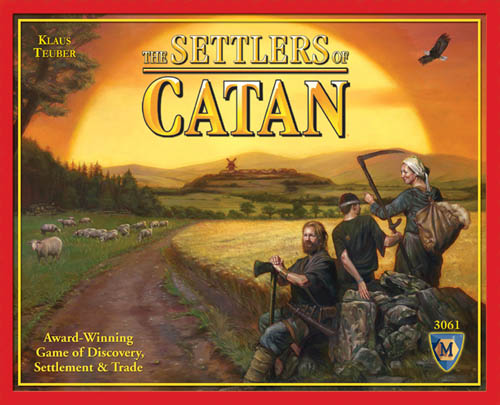Key Designer: Klaus Teuber
Distributor: Mayfair Games
As I mentioned earlier, Catan was one of the first games that helped me recognize the beauty of gaming and game night. My first encounter with Settlers of Catan was a prolonged affair, attended by the ceremony of clearing our dining room table for play space and fishing out snacks from the kitchen cabinet. My brother, opening the board game with much care, presented it along with a set of simplified rules for each of us to read and refer to throughout our first game. Catan was the first resource management game I encountered.
The rules of Catan were easy to understand within a few turns. The board consists of hexagonally-shaped resource pieces (brick, lumber, wool, grain, and ore) numbered from 2-12 with token counters. At the beginning of the game, each player sets up two settlements and four roads. A player’s turn consists of three parts: rolling the dice, collecting resources, then trading resources and/or purchasing settlements, cities, roads and/or development cards. The dice roll determines which resources are rewarded. If the dice roll amounts to 12, for example, the resource with the corresponding number is awarded to players with connecting settlements. Victory Points are awarded for settlements, cities, roads, certain development cards, and achievements (i.e. largest army or longest road). The first player with 10 VP wins the game.
Catan requires a combination of skill, cooperation and luck. It takes a knowledgeable player to position settlements and ration resources, a good negotiator to obtain needed resources from others, and a bit of luck with the dice to gather the rest of the resources (during one game, for example, I monopolized ore in my position between the usually rare numbers 11 and 10. For the entire game, 11 and 10 seemed to be the only numbers rolled and I won the game based on this lucky streak). The game allows for a variety of techniques to obtain VP.
As my review has shown, Catan is a good game. Unfortunately for me, game play can run kind of long. When you sit down to a game of Catan, be ready to spend about two hours on it (sometimes even three!). I know that by most standards this wouldn’t be considered long, but I played Catan shortly after playing Gloom and found Catan to be painfully slow in comparison. As with all games, gather the right mix of players who jibe well with your play personality and you’re sure to have fun. Combine a deliberate thinker with a game like Catan, which allows so many options, and impatient players like me could have a torturously long experience ahead of them.
That being said, Catan is a good game, but not a great game in my books. I have to be in a specific mood to play Catan: ready for a relatively long game with long turns of negotiations. These things may signify an amazing game for others, but I enjoy a game that’s fast-paced and allows one to lose oneself – if not in the other players then at least in the play experience itself. Personally, I think Catan has great mechanics, but doesn’t do enough to push me beyond the realm of participating in the game to actually living the game and becoming seriously invested in it. Mere resource gathering and distribution does not do enough to attract me. Instead, I enjoy a game that presents an entire package, and this package includes, not just its end aim (the point of winning), but its design and the story it creates too. Unfortunately, I feel Catan is lacking in the latter two criteria; it doesn’t do enough to create a story and it’s not the most attractive game either. I know I’m not expressing the predominant opinion (almost all reviews are unanimously in favor of Catan), but I am expressing it honestly from the point of view of a generally impatient, very demanding gamer and hope it may benefit others with similar tastes out there too.



